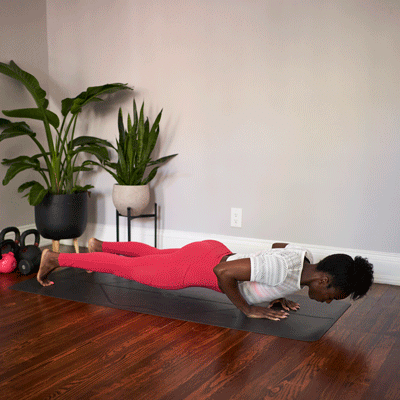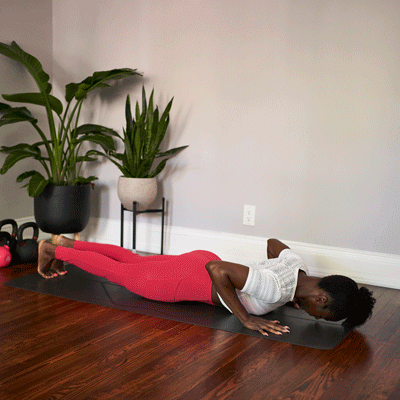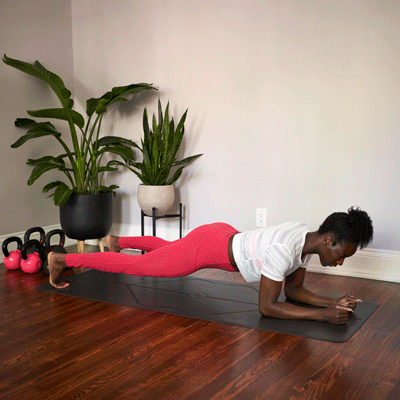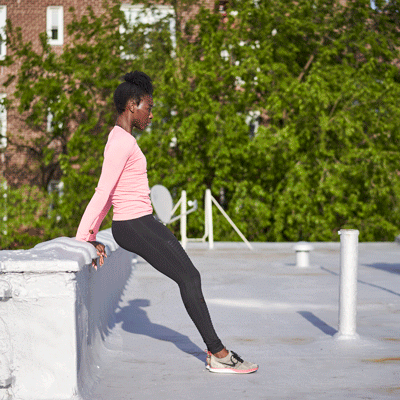If you’ve been stuck doing overhead extensions on repeat when arm day comes around, we wouldn’t blame you for wanting to ignore those triceps.
After all, without access to a gym and fancy equipment, it’s pretty much impossible to work those tricky underarm muscles, right?
Heck no!
That’s why we put together this list of exercises you can do with dumbbells, a resistance band, or good old-fashioned body weight. Mix and match your favorites, and then scroll to the bottom for a foolproof workout formula put together by top trainers.
(And when you’re done with your triceps, check out these killer at-home routines for your shoulders, legs, and back.)
No exercise equipment at home? Just use what your mama gave ya. From push-up variations to simple triceps dips, flimsy triceps don’t stand a chance.
Close-grip (narrow-grip) push-up
Start in a strong plank position with abs tight and body in a straight line from your heels to the top of your head. Place hands closer than shoulder-width apart but not touching, or in a diamond shape (we’ll get to diamond push-ups in a minute).
Keep elbows close to torso as you lower yourself to the floor and as you push back up to the starting position.
Pro tip: You’ll get a good ab workout if you keep them taut for the entirety of this exercise. Tight abs also keep your hips from sagging, which can strain your lower back.
Diamond (or triangle) push-up

Start in a plank position, keeping spine in a straight line and abs tight. Place hands directly beneath chest with pointer fingers and thumbs touching, creating a diamond shape.
Keep elbows close to torso as you lower yourself to the floor and as you push back up to the starting position.
Pro tip: Try NOT to flare your elbows out. Keep them close to your torso to activate your triceps.
Pike push-up
Start in Downward-Facing Dog: Press your hands and feet into the floor and lift your glutes toward the ceiling, creating a triangle with your body. (This is probably the only push-up position in which you want your glutes and hips higher than your torso.)
Keeping your hips up, bend your elbows and lower your body until your elbows almost touch the floor. Slowly push back up to the starting position.
Pro tip: You can increase the difficulty by elevating your feet.
Bodyweight triceps extension

Start in a forearm plank position with elbows under shoulders and hands out in front of your body. Pressing through your hands, lift your body into a high plank position, and then slowly lower until elbows touch the floor again.
Pro tip: Your hands should be in front of your body rather than under your shoulders as they would be in a classic push-up or plank. Go slow and keep your elbows tucked into your torso to target your triceps.
High-low plank (or walking plank)

Start in a plank position with hands directly under shoulders. Lower your right forearm to the floor, with elbow directly under shoulder. Lower your left forearm to the floor. You should now be in a forearm plank position.
Place right hand under right shoulder and then left hand under left shoulder, pressing back into a high plank position.
Do 1 set leading with right hand and another set leading with left hand.
Pro tip: Keep your hips even (no swaying) and abs tight throughout the exercise.
Bench triceps dip

Use a couch, bench, or sturdy chair for this exercise.
Sit on the bench. Place your hands on the bench, with thumbs next to hips and fingers pointing toward the floor. Extend legs straight in front of you and move your glutes in front of the bench so your body weight rests on your hands.
Slowly lower your body until elbows reach a 90-degree angle, then press back up into the starting position.
Pro tip: You can make this exercise easier by bending your knees or harder by placing your feet on a chair so both your upper and lower body are elevated.
Triceps bow (aka dive bomber)
Place hands shoulder-width apart on a bar or the edge of a counter or table and get into a plank position.
With elbows at the sides of your torso, keep your back and head straight as you bend elbows to bring your head under the bar, counter, or table.
Push your body back up into the starting position.
Pro tip: The further your feet are from the bar, the more difficult this exercise will be.
Dumbbells add resistance and provide a way to increase resistance as you get stronger. But you can still do great work with only one set of weights.
Triceps kickback
Holding a dumbbell in each hand in a neutral grip (with palms facing each other), slightly bend knees and lean forward at your hips. (Keep abs tight and head in line with spine. Your torso should almost be parallel to the floor.)
Tuck upper arms close to your body and hold the dumbbells at a 90-degree angle. Straighten your arms, isolating your triceps. Then return your hands to the starting position.
Pro tip: Your upper arms and elbows should remain still to fully engage your triceps.
Double dumbbell skullcrusher (Lying overhead triceps extension)
Lie on the floor or a bench, holding a dumbbell in each hand in a neutral grip. Extend arms straight toward the ceiling.
Keeping upper arms and elbows steady (you want them to move as little as possible), bend at your elbows, slowly lowering the dumbbells to a 90-degree angle.
Slowly return your arms (and the dumbbells) to the starting position.
Pro tip: Keep your knees bent to prevent uncomfortable pressure on your lower back.
Overhead triceps extension
This exercise can be done standing or seated.
Hold the dumbbells overhead in a neutral grip with arms straight and feet hip-width apart. With upper arms by ears and the dumbbells touching, bend your elbows, lowering the weights behind your head.
Push the weights back up to the starting position.
Pro tip: Keep your upper arms as immobile and steady as possible to better isolate your triceps.
Dumbbell floor press
Lie on the floor with knees bent. Holding the dumbbells in an overhand grip, rest your triceps on the floor so your arms are at 90-degree angles.
Press the dumbbells toward the ceiling, lightly touching them as your arms fully extend. Slowly bring them back to the starting position.
Pro tip: This exercise takes pressure off your shoulders while working your chest and arms.
Close-grip dumbbell press
Lie on the floor with knees bent. Hold a single dumbbell with both hands over your chest.
Press the weight toward the ceiling until your arms are fully extended. Slowly bring the dumbbell back to the starting position.
Pro tip: This exercise also works your chest.
Resistance bands work your triceps and develop stability in the surrounding muscle groups and ligaments.
Triceps kickback
Yes, we did this one with dumbbells, but resistance bands increase the difficulty as you reach the apex of the kickback. That means an extra dose of fire for those tris.
Stand on the center of the band, holding one end or handle in each hand. Bend your knees. Keeping spine, neck, and head straight, bend at your waist.
Holding your upper body steady, place upper arms against torso and your hands close to your chest or at a 90-degree angle.
Move your hands behind you until your arms are straight. Bring hands back to the starting position.
Pro tip: Your upper arms should remain stationary throughout this exercise. You can increase the resistance by gripping the resistance bands closer to your feet.
Resistance band triceps pushdown
Resistance bands are used in place of the high cable pulley you’d use at the gym. Attach the resistance band at the midpoint to an overhead object like a pull-up bar, a clothes rod, or a sturdy door anchor (like the kind that hangs over the top of the bathroom door for extra towels).
Facing the anchor point and holding one end of the resistance band in each hand, tuck elbows in close to torso. Bend at elbows so your hands are at your chest.
Adjust your grip so there’s tension in the band. Press hands down, keeping elbows firmly in place at your sides. Slowly return to the starting position.
Pro tip: Keep your abs tight, back straight, and elbows close to your body to isolate your triceps.
Overhead press
With left foot, stand on one end of the resistance band. Hold the other end in left hand, with hand behind your head. You should feel light tension in the band.
Point left elbow toward the ceiling as you fully extend left arm. Slowly lower left hand back to the starting position. After doing reps on one side, repeat on the other side.
Pro tip: You can adjust the resistance by shortening or lengthening your grip on the resistance band.
Reverse resistance plank with triceps dip
Sit on the floor with legs extended in front of you. Place the resistance band over your thighs, with the ends on the floor. Place your hands on top of the ends of the band, with fingers pointed forward.
Bend elbows and use glutes and legs to lift your hips until your body forms a straight line heels to head. Your pelvis should press into the band.
At the top of the plank, do 10 small triceps dips by bending and straightening your arms at the elbows.
Pro tip: If performing this exercise hurts your wrists, bring it down to your forearms.
Plank triceps kickback
Secure the resistance band to a chair/couch/sturdy object in front of you.
Start in a single-arm forearm plank position. Hold the resistance band in your other hand, keeping elbow tight to torso. Keep shoulder and elbow still as you straighten your arm in a kickback motion.
Repeat on the other side.
Pro tip: Keep your elbow close to your torso to isolate your triceps.
We’ve given you more than enough exercises to choose from, but how do you put them together to make your own customized triceps routine? We consulted April Blais, owner and certified personal trainer at The Training Station, and Fawn Lee, owner and certified personal trainer at Fitness with Fawn.
According to Blais and Lee, working those triceps just two or three times a week will deliver visible results. And you can tailor your routine to your preferences and goals.
“Banded and dumbbell exercises are fairly interchangeable. You get more resistance with banded workouts versus dumbbell,” said Blais. “Bands provide resistance while targeting stabilizers and ligaments as they build strength.”
She recommends them to her clients when they’re targeting smaller muscle groups like the triceps. “But follow the general rule of thumb that the lighter the weight [you use], the higher the reps. Our bodies would cave if we were doing high weights and high reps,” she says.
So here’s the secret formula:
- Pick 3 or 4 exercises from our list for a single workout.
- You can mix dumbbell, resistance band, and bodyweight exercises and switch it up between circuit training and supersets to keep challenging your body.
- Do 3 or 4 sets of your chosen exercises with 12–15 reps per set.
- If you’re doing a circuit, take a 2- to 3-minute break between sets. (This can help you maximize blood flow and muscle breakdown, says Lee.)
- If you prefer a superset (ideal for working multiple muscle groups), switch between 2 exercises without rest in between, and then take a 1-minute break before your next set. To get you started, Blais suggests doing a chest exercise like a bench press (with dumbbells if you’re at home) and then switching to a triceps exercise like a dip, triceps kickback, or triceps extension.
- Ideally, create at least two different routines to use throughout the week.
- Start slow, focusing on proper form and isolation of the triceps. As you improve, add weight in increments.
The key, according to Lee, is to “mix it up so that the body doesn’t adapt, because it does that pretty quickly. A mix of bodyweight and dumbbell exercises shock the body.”
Basically, the more you do the exercises, the more efficient your body becomes and the fewer gains you see over time. After you’ve done the same routine for 3 to 4 weeks, switch it up to keep your body guessing.
“Use a weight that leaves you feeling tired on about rep 9,” said Blais. If you’re feeling tired on rep 3 or 4, you’ve probably got too much weight.
Your goal: muscle breakdown. Exercise breaks down the muscle tissue, but the muscle-building phase takes place during rest and recovery, especially sleep. To maximize the benefits of your triceps workouts, get at least 7 to 9 hours of sleep and take at least one rest day between triceps workouts.
Warmups and stretching are an important part of any workout.
“Try 5 to 10 minutes of cardio to get the blood flow going. Then, do a few triceps warmup exercises,” like 20 triceps extensions or kickbacks with no weight, says Lee.
Add an overhead stretch by raising one arm toward the ceiling and then bending it at the elbow so your hand goes behind your head. Use your other arm to gently tug on your bent elbow to stretch your triceps.
A consistent routine that includes a warmup, stretching, and a series of triceps exercises will have those underarms taut and svelte. Plus, your triceps aren’t the only muscle group that will get stronger. Your shoulders, biceps, and pectoral muscles often activate when you’re working your triceps.
It doesn’t take much to strengthen a small muscle group like your triceps. Consistency and switching up your routine every 3 to 4 weeks should be enough for a noticeable difference.


